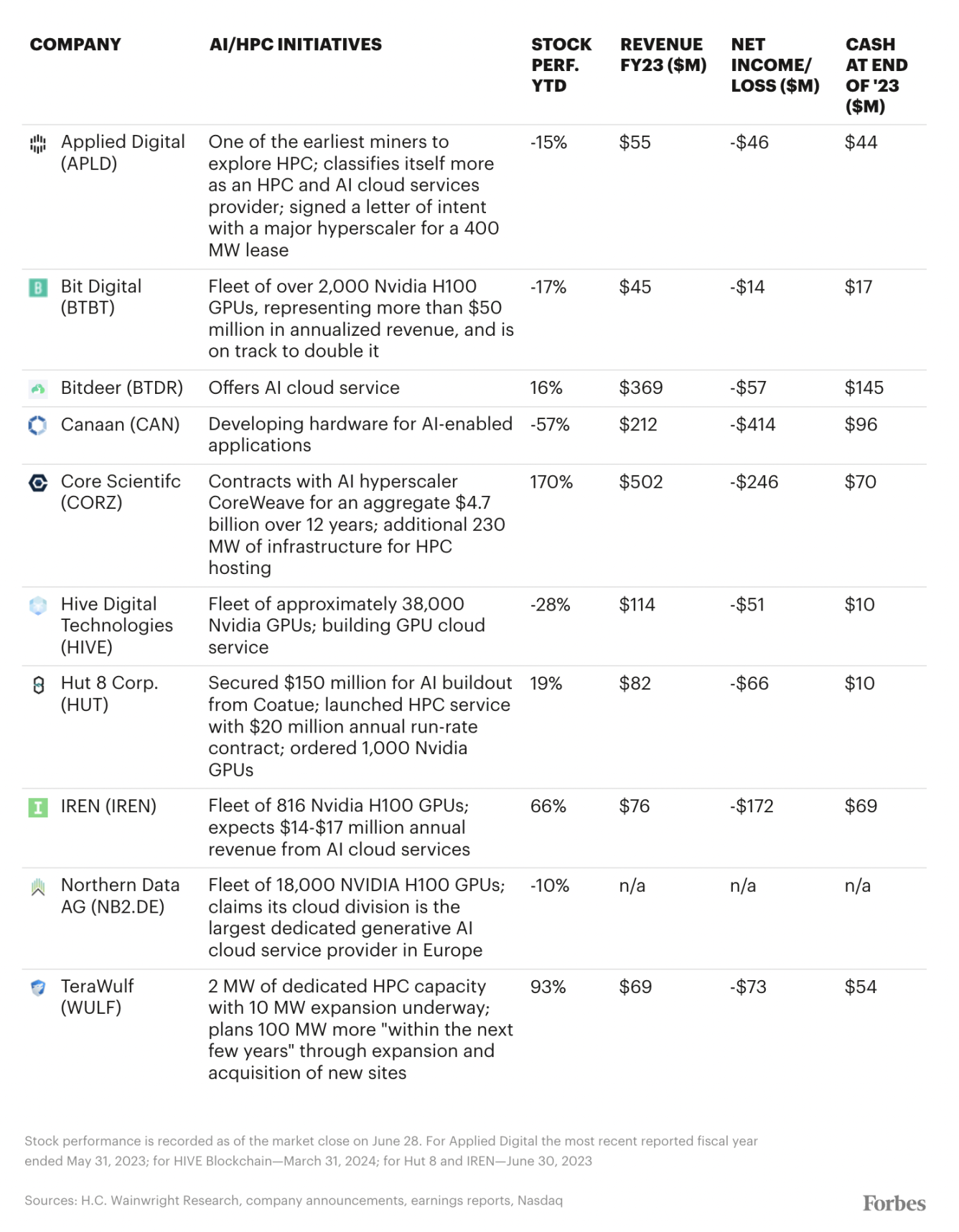Forbes: Tại sao các công ty khai thác Bitcoin sẽ trở thành cổ phiếu khái niệm AI?
Bài viết gốc của Nina Bambysheva, Forbes
Bản dịch gốc: Luffy, Tin tức tầm nhìn xa
Power resources have become a hot commodity in the field of artificial intelligence (AI). Take cloud computing provider CoreWeave, for example, which signed a $3.5 billion partnership agreement with Core Scientific earlier this month. Under the agreement, CoreWeave will pay $290 million per year for 12 years to the Austin-based bitcoin mining companys data center to host AI-related computing hardware. In addition, CoreWeave will also cover all capital expenditures.
The deal was a good deal for Core Scientific, whose stock price doubled to $10 in early June. Some observers believe that Core Scientific has become a new weapon in the field of artificial intelligence. On June 26, CoreWeave announced a second collaboration, which is expected to bring Core Scientific $1.2 billion in revenue in the next few years. As one of the largest Bitcoin miners in North America, Core Scientific once had difficulties in operation and only got rid of the crisis of bankruptcy in January this year.
AI applications like ChatGPT are driving a surge in demand for large computer capacity (a ChatGPT query uses 10 times more power than a traditional Google search), making companies like Core Scientific attractive because they can use cheap electricity in places like Texas and North Dakota and have agreements to get more energy from other places. Lawrence Berkeley National Laboratory Research Center says it usually takes 3-5 years to build a high-performance computing (HPC) data center from scratch, and the current waiting time for a grid connection is as long as 6 years, so having enough power is crucial at this time.
Adam Sullivan, CEO, Core Scientific
“The demand is unlimited,” said Adam Sullivan, CEO of Core Scientific. “If we just execute within the scope of what’s currently contracted, we will be one of the top 10 data center companies in the U.S. and host a significant portion of the AI hardware in the U.S. in the next few years.”
JPMorgan research shows that since Core Scientific announced its first CoreWeave partnership on June 3, the total market value of 14 U.S.-listed Bitcoin miners has soared 22%, in stark contrast to Bitcoins 12% drop and the SP 500s 4% rise.
The 14 miners control about 5 GW of power, of which 3.6 GW is available for HPC, according to a June 24 research note from JPMorgan. They also have purchase agreements for another 4.5 GW from new power plants in various stages of construction and permitting.
That’s enough energy to power about 3.4 million homes for a year. Fueled by the boom in artificial intelligence, data center energy demand could surge to 9% of U.S. electricity generation by 2030, according to the Electric Power Research Institute. That projected increase is more than double current electricity use.
But miners can’t easily redirect excess electricity toward AI. “It’s hard to get a lot of power in the short term, and that’s one of the big assets that many U.S. bitcoin miners have right now, but those power contracts are only valuable if they have some supporting infrastructure, primarily fiber optic connections,” said Wes Cummins, CEO of data center developer Applied Digital. Fiber optic cable is crucial in high-performance computing because it enables high-speed data transmission.
“Bitcoin purists will counter by saying, ‘No, you can’t host AI machines in a Bitcoin mining center.’ OK, I get it. You need cleaner air and better cooling,” noted Kevin Dede, an analyst at HC Wainwright. But he added that smaller AI players may not have the same interest as the hyperscalers (companies with massive data centers and cloud infrastructure such as Amazon’s AWS, Microsoft Azure and Google Cloud), but could better fit into the range of services offered by Bitcoin miners, which could eventually lead to a Bitcoin mining/HPC data center hybrid.
Investors agree.
“Over the past three weeks, there has been a re-rating of listed bitcoin mining stocks as the value of miners’ power assets has come to the fore,” Mark Palmer, an analyst at investment bank Benchmark, wrote in a June 21 research note. “The average enterprise value multiple for a group of listed miners, including IREN, TeraWulf and BitDigital, now stands at 7.8, up from 5.2 two months ago.”
For mining companies that have just experienced the halving of Bitcoin block rewards, the rise of artificial intelligence has brought about a bright future for electricity demand. The halving of rewards to 3.125 BTC has caused mining revenue to fall to an all-time low. In addition, we found that none of the 10 miners involved in AI projects made a profit last year, and although Bitcoin has slowly recovered from the impact of the 2022 crypto winter, it is still trading below the cost of mining.
While Core Scientific is in the spotlight, several other mining companies have been adjusting their operations to capitalize on artificial intelligence.
IREN
IREN, formerly Iris Energy, was one of the first companies to realize this opportunity. JPMorgan believes that IREN is the miner most likely to take advantage of HPC/AI demand based on its timely actions to build high-quality data centers. The company also recently purchased 816 Nvidia H 100 GPUs (arguably the most powerful chip in the AI field). Mike Colonnese, another analyst at HC Wainwright, said: With the exception of Core Scientific, IREN and Hut 8, we havent really seen such high levels of revenue from AI business in mining companies.
Hut 8
The Miami-based bitcoin miner announced that it had received $150 million in funding from Coatue Management to build out AI-related infrastructure. Coatue will purchase a five-year bond that can be extended for up to three years. The debt will pay 8% interest, and Coatue can convert the debt into stock at $16.395 per share, which is 45% higher than the stock price when the deal was announced, and Hut 8s stock price has now risen to $14.99.
Asher Genoot, CEO, Hut 8
“We want to grow and build with partners that have scale or can coexist for the long term, and these partners must be well-known companies in the broader ecosystem and the field of artificial intelligence. We are in dialogue with many such partners,” said Asher Genoot, CEO of Hut 8. He claimed that the key is not only which companies will have the opportunity to enter this market, but also which companies will have the ability to achieve this goal, and Hut 8 is one of them.
Benchmark’s Palmer agreed: “Hut 8 has demonstrated that it can build energy assets and data center oases relatively quickly and cost-effectively.” He rates Hut’s stock a buy with a $17 price target.
Applied Digital
Applied Digital is one of the first miners to turn to building HPC data centers, and the company recently signed a letter of intent with an unnamed U.S. hyperscale computing provider to lease 400 megawatts of power. HC Wainwrights Dede said the companys Jamestown, North Dakota, facility is an interesting example of an attempt to balance mining and HPC work, a so-called mullet data center. Such facilities combine high-performance computing with bitcoin mining when there is excess power capacity.
“I think people are very focused on power right now, but if you want to move your business from bitcoin mining to HPC, a lot of other factors are very important,” said CEO Cummins, who pointed to waiting times of more than 2.5 years for critical electrical equipment and a shortage of talent with experience in large data centers. “We’ve invested a lot of time in this, worked out the supply chain issues, and hired business experts. We really see ourselves as the HPC infrastructure company of the future.”
Needham analyst John Todaro named Applied Digital a top pick in the HPC/AI space, while also highlighting IREN, Core Scientific, TeraWulf, Bitdeer, Hut 8, Bit Digital, and HIVE Digital Technologies.
Traditional crypto business remains strong for pure-play crypto companies like Riot, CleanSpark and Marathon Digital Holdings (the three largest U.S. bitcoin miners by market cap). Bitcoin is near all-time highs, and support from rising macroeconomic and political uncertainty is unlikely to fade anytime soon.
CleanSpark CEO Zach Bradford said in a statement to Forbes: I believe the best use of our resources is to focus on Bitcoin mining. Not only will this help stabilize the power grid, but we are also helping shape the future of money. Some of our data centers can support HPC, but we believe that we are making a more positive impact and succeeding with our current strategy (Bitcoin mining business).
Marathon has actually expanded its mining operations to support the new PoW cryptocurrency kaspa (KAS). “By mining kaspa, we are able to create a revenue stream that is separate from bitcoin,” said Adam Swick, Marathon’s chief development officer, in a statement on the company’s website. In March, Forbes included Kaspa on its list of zombie blockchains due to its limited use.
CleanSpark announced earlier this month that it had added five mining farms in Georgia, investing a total of $25.8 million, and on June 27 said it had agreed to acquire its peer Grid Infrastructure in an all-stock transaction valued at $155 million. Meanwhile, Riot is trying to take over its competitor Bitfarms through a proxy war.
An analyst who goes by the handle pennyether on X warned that pure mining investors should be more cautious. “They have already priced in the rise of Bitcoin, but if Bitcoin doesn’t rise as expected, for example, Bitcoin prices stay flat for a year, I can’t imagine what kind of disaster many mining stocks will face.”
Of course, entering a new, highly complex industry is difficult, Colin Harper, director of content and research at Luxor Technologies, a bitcoin mining services company, wrote. “The prospect becomes even more difficult when you realize that miners will be competing with some of the largest and most well-capitalized technology companies in the world.”
HC Wainwrights Colonnese said that building AI data center infrastructure can cost up to $10 million per megawatt, while Bitcoin mining farms cost between $300,000 and $500,000 per megawatt. The market generally responds well to anything related to AI, but these are very capital expenditure-intensive areas, he said.
Still, for those with the infrastructure and power capacity available, the shift to AI could offer compelling benefits. By replacing bitcoin’s volatility with steadier revenue from AI calculations, miners could benefit from predictable budgets funded by existing customers. It also helps miners increase revenue so they can afford the high capital investments needed to compete with new mining equipment, Morgan Stanley analysts concluded in an April report.
“The fact is, AI companies are willing to pay more for it because they don’t care. Their business model is stronger. With bitcoin mining, you don’t know what the price of bitcoin is going to be or how hard it is to mine, so you take on more risk,” Dede said.
The Morgan Stanley report highlights several mining sites that are suitable for data center conversion, including sites in Texas, Georgia, Canada, the United Arab Emirates and Bhutan. Needham analysts said most mining sites seeking conversion would face capital expenditures of more than $6 million per megawatt.
For many mining companies, this is an opportunity not to be missed.
“This doesn’t mean miners are going to completely reinvent their business,” said Phil Harvey, CEO of Sabre 56, a hosting provider and digital asset mining consultancy. “They’ve invested a lot of money, time and effort into cryptocurrencies.” But “it would be foolish not to treat it (data centers) as a business,” he added. “It makes your investment universe much broader. Private equity firms are investing in HPC/AI because investors don’t want to miss out on the AI wave.”
This article is sourced from the internet: Forbes: Why Bitcoin mining companies will become AI concept stocks?
Related: Why do almost all Web3 social applications fail?
Original title: The Social App Thesis: Why every winning onchain app will be social Original author: David Phelps Original translation: Ismay, BlockBeats Editors note: We live in a capitalist world that believes that money is omnipotent. However, true cultural power is not always proportional to wealth. Being rich not only brings a certain kind of political and cultural influence, but it can also lead to a lack of another kind of cultural power. This article delves into the relationship between the merchant class and cultural tastemakers, revealing the difficulty of converting between money and status. Although there are theoretically many ways to convert financial capital into social capital, it is challenging in practice. We explore the reasons behind this phenomenon and use the cases of Web2 and Web3 to explain…










